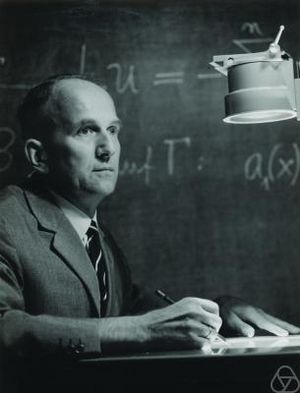Collatz conjecture facts for kids
The Collatz conjecture is a super interesting idea in mathematics. It's like a puzzle that many smart people think is true, but no one has proven it yet! It's named after a German mathematician named Lothar Collatz. He first thought of this puzzle way back in 1937.
This puzzle is about what happens when you follow a simple set of rules, starting with any whole number. You keep doing the rules over and over again. The amazing thing is, no matter what number you start with, the Collatz conjecture says you will always end up at the number one!
Contents
How the Collatz Rules Work
The rules are quite simple. You pick a number, let's call it n. Then you do one of two things:
- If n is an even number (meaning you can divide it by two without anything left over), you just cut it in half. So, n becomes n divided by 2.
- If n is an odd number (meaning it can't be divided by two evenly), you multiply it by three and then add one. So, n becomes
 .
.
You keep applying these rules to the new number you get, until you reach the number one. The Collatz conjecture says this will always happen!
An Example: Starting with 9
Let's try an example to see how it works. We will start with the number 9:
- 9 (This number is odd, so we multiply by 3 and add 1:
 )
) - 28 (This number is even, so we divide it by 2:
 )
) - 14 (This number is even, so we divide it by 2:
 )
) - 7 (This number is odd, so we multiply by 3 and add 1:
 )
) - 22 (This number is even, so we divide it by 2:
 )
) - 11 (This number is odd, so we multiply by 3 and add 1:
 )
) - 34 (This number is even, so we divide it by 2:
 )
) - 17 (This number is odd, so we multiply by 3 and add 1:
 )
) - 52 (This number is even, so we divide it by 2:
 )
) - 26 (This number is even, so we divide it by 2:
 )
) - 13 (This number is odd, so we multiply by 3 and add 1:
 )
) - 40 (This number is even, so we divide it by 2:
 )
) - 20 (This number is even, so we divide it by 2:
 )
) - 10 (This number is even, so we divide it by 2:
 )
) - 5 (This number is odd, so we multiply by 3 and add 1:
 )
) - 16 (This number is even, so we divide it by 2:
 )
) - 8 (This number is even, so we divide it by 2:
 )
) - 4 (This number is even, so we divide it by 2:
 )
) - 2 (This number is even, so we divide it by 2:
 )
) - 1 (We reached 1! After 1, the sequence goes 4, 2, 1, and so on, in a loop.)
Why is it a Conjecture?
In mathematics, a "conjecture" is an idea that many smart people believe is true. They might have lots of evidence for it, like testing billions of numbers and seeing that the Collatz conjecture always holds true. However, a conjecture is not a proven fact until someone can show a mathematical proof that works for every single number possible.
Even though computers have tested numbers up to incredibly large values (like 268, which is a huge number!), and they all eventually reach 1, no one has found a way to prove it for all numbers. This is why the Collatz conjecture is still one of the biggest unsolved puzzles in mathematics!
Images for kids
-
Collatz map fractal in a neighbourhood of the real line
See also
 In Spanish: Conjetura de Collatz para niños
In Spanish: Conjetura de Collatz para niños










